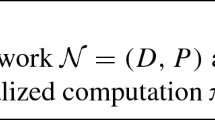Abstract
Local area networks (LANs) and everyday speech inspire a model of communication by unbuffered broadcast. Computation proceeds by a sequence of messages, each transmitted by one agent and received by zero or more others. Transmission is autonomous, but reception is not. Each message is received instantaneously by all agents except the transmitter, but is read only by those who were monitoring it at the time; others discard it. As in CCS, agents learn about the environment only through the messages they read. Programming such a system is hard because we have to ensure that messages are read.
Testing resembles a viva-voce examination. Observation, restriction and hidden actions differ from their CCS counterparts, as does testing equivalence.
We capture this model in a Calculus of Broadcasting Systems (CBS). We use transition systems with transmit, read and discard actions. Discards are self-loops, and only auxiliary. We have some results on strong bisimulation and testing, but much work remains to make CBS tractable.
Chapter PDF
Similar content being viewed by others
Keywords
These keywords were added by machine and not by the authors. This process is experimental and the keywords may be updated as the learning algorithm improves.
References
Norman Abramson. The Aloha system—another alternative for computer communications. In FJCC, pages 281–285, 1970.
M. Ben-Ari. Principles of Concurrent and Distributed Programming. Prentice-Hall, 1990.
G. Berry, P. Couronné, and G. Gonthier. Synchronous programming of reactive systems: An introduction to ESTEREL. Technical Report 647, INRIA, 1986.
Bard Bloom, Sorin Istrail, and Albert R. Meyer. Bisimulation can't be traced. In 15th Symposium on Principles of Programming Languages. ACM, 1988.
J. A. Bergstra, J. W. Klop, and J. V. Tucker. Process algebra with asynchronous communication mechanisms. In Seminar on Concurrency, pages 76–95. Carnegie-Mellon University, July 1984. Springer Verlag LNCS 197.
Manfred Broy. Broadcasting buffering communication. Comput. Lang., 13(1):31–47, 1988.
K. Mani Chandy and Jayadev Misra. Parallel Program Design—A Foundation. Addison-Wesley, 1988.
S. T. Chanson, G. W. Neufeld, and L. Liang. A bibliography on multicast and group communication. Operating Systems Review, 23(4), October 1989.
Rocco de Nicola and Matthew Hennessy. Testing equivalences for processes. Theoretical Computer Science, 34:83, 1984.
Narain Gehani. Broadcasting sequential processes. IEEE Trans. on Software Engg., 10(4):343, July 1984.
J.F. Groote. Transition system specifications with negative premises. In CONCUR '90, 1990. Springer Verlag LNCS 458.
Matthew Hennessy. Algebraic Theory of Processes. MIT Press, 1988.
Matthew Hennessy. CSP with value-passing. Technical Report HPL-ISC-TM-90-025, Hewlett Packard Ltd., 1990.
Matthew Hennessy and Anna Ingolfsdottir. A theory of communicating processes with value-passing. Technical Report 3/89, University of Sussex, 1989. Also presented at ICALP 90.
C. A. R. Hoare. Communicating sequential processes. Communications of the ACM, 21(8):666–677, August 1978.
C. A. R. Hoare. Communicating Sequential Processes. Prentice Hall, 1985.
He Jifeng, Mark Josephs, and C.A.R. Hoare. A theory of synchrony and asynchrony. Technical report, Programming Research Group, Oxford University Computing Laboratory, January 1990.
Bengt Jonsson. A hierarchy of compositional models of I/O automata. Technical report, Swedish Institute of Computer Science, 1990.
Mark Josephs and Jan Udding. Delay-insensitive circuits: an algebraic approach to their design. In CONCUR '90, 1990. Springer Verlag LNCS 458.
R. M. Metcalfe and D. R. Boggs. Ethernet: Distributed packet switching for local computer networks. Communications of the ACM, 19(7), July 1976.
Robin Milner. A Calculus of Communicating Systems. Lecture Notes in Computer Science. Springer-Verlag, 1980.
Robin Milner. Communication and Concurrency. Prentice Hall, 1989.
Amir Pnueli. Linear and branching structures in the semantics and logics of reactive systems. In Springer Verlag LNCS 194. ICALP, 1985.
M. Sloman and J. Kramer. Distributed Systems and Computer Networks. Prentice Hall, 1988.
R. K. Shyamasundar, K. T. Narayana, and T. Pitassi. Semantics for nondeterministic asynchronous broadcast networks. Technical report, Pennsylvania State Univ., March 1987.
Frits Vaandrager and Jan Groote. Structured operational semantics and bisimulation as a congruence. In Springer Verlag LNCS 372, pages 423–438. ICALP, 1989.
Glynn Winskel. Synchronization trees. Theoretical Computer Science, 34:33–82, 1984.
Author information
Authors and Affiliations
Editor information
Rights and permissions
Copyright information
© 1991 Springer-Verlag Berlin Heidelberg
About this paper
Cite this paper
Prasad, K.V.S. (1991). A calculus of broadcasting systems. In: Abramsky, S., Maibaum, T.S.E. (eds) TAPSOFT '91. CAAP 1991. Lecture Notes in Computer Science, vol 493. Springer, Berlin, Heidelberg. https://doi.org/10.1007/3-540-53982-4_19
Download citation
DOI: https://doi.org/10.1007/3-540-53982-4_19
Published:
Publisher Name: Springer, Berlin, Heidelberg
Print ISBN: 978-3-540-53982-7
Online ISBN: 978-3-540-46563-8
eBook Packages: Springer Book Archive




